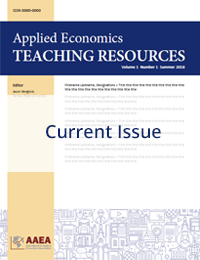Extension Education
Challenges with Developing an Extension Program for Markets Evolving under an Uncertain Framework: Lessons from Program Development for Carbon and Hemp Markets
Charley C. Martinez(a), S. Aaron Smith(a), Tyler Mark(b), and Paul Goeringer(c)
University of Tennessee(a), University of Kentucky(b), and University of Maryland(c)
JEL Codes: Q13, Q15, Q16, Q19
Keywords: Carbon markets, Extension, hemp, new markets, programming
First Published Online: August 28, 2022
Volume 4, Issue 3
Abstract
Extension programs are the link between producers, applied research, and policy. Additionally, Extension educators are often the initial point of contact for producers when new agricultural markets emerge. Emerging markets provide opportunities and challenges for all producers. However, developing an Extension program to assist producers can be difficult due to limited production information (or process clarity), a lack of infrastructure, uncertain marketing channels, and uncertain policy direction. During the emergence of new commodities or markets, the development of Extension programming is necessary to aid producers and other agricultural stakeholders in clarifying the risks and rewards of entering or participating in the market. A further complication is a bimodal distribution of clientele ranging from those operators new to agriculture to established operators.
The development of carbon and hemp markets in the United States highlights the difficulties in providing producers with timely information when a highly uncertain policy and regulatory environment exists. This paper discusses how to develop an Extension program to address producers’ needs for emerging markets effectively. Specifically, we highlight the benefits of collaboration, obtaining grant funding, program development, and identifying research topics. Finally, the program development discussed can be utilized by Extension educators when developing programming for future emerging markets.
References
Campbell, B., T. Mark, B. McFadden, and A. Rabinowitz. 2021. “July 2021—Reporting Survey Data From February Through April.” Hemp Economic Marketing Research 2021. Newark, Delaware. Available at: https://www.udel.edu/content/dam/udelImages/canr/pdfs/apec/hemp/Feb-AprUpdated.pdf
Cui, X., and S.A. Smith. 2020. “University of Tennessee Extension’s 2020 Hemp Industry Survey.” University of Tennessee Extension Publication W917. Knoxville, Tennessee. Available at: https://extension.tennessee.edu/publications/Documents/W917.pdf
Kolodinsky, J., and H. Lacasse. 2021. “Consumer Response to Hemp: A Case Study of Vermont Residents from 2019 to 2020.” GCB Bioenergy 13(4):537–545.
Mark, T., and W. Snell. 2019. “Economic Issues and Perspectives for Industrial Hemp.” In D.W. Williams, ed. Industrial Hemp as a Modern Commodity Crop. Madison WI: American Society of Agronomy, Crop Science Society of America, and Soil Science Society of America, pp. 107–118.
Mark, T., J. Shepherd, D. Olson, W. Snell, S. Proper, and S. Thornsbury. 2020. “Economic Viability of Industrial Hemp in the United States: A Review of State Pilot Programs.” United States Department of Agriculture, Washington D.C. Available at: https://ageconsearch.umn.edu/record/302486/
NBC-LEX18. 2019. “Kentucky Farmers Sue Hemp Company.” October 21, 2019.
Nriagu, E. 2021. “EPA Carbon Credit.” Retrieved from Center for Automotive Research. Ann Arbor, MI: https://www.cargroup.org/epa-carbon-credit/
Oleck, J. 2021. “A $65.5 Million Jury Verdict in Montana Reflects Industrial Hemp’s Dramatic Fall in Value.” Forbes.com. August 6, 2021.
Plastina, A. 2021. “How Do Data and Payments Flow Through Ag Carbon Programs?” Iowa State University Extension Publication Number A1-77. Ames,IA. Available at: https://www.extension.iastate.edu/agdm/crops/pdf/a1-77.pdf
Schneider, G. 2020. “Kentucky Hemp, CBD Giant’s Bankruptcy Is a ‘Black Eye’ for Industry, Congressman Says.” Louisville Courier Journal. February 6, 2020.
Shockley, J., and W. Snell. 2021. “Carbon Markets 101.” Economic and Policy Update (21):4, Department of Agricultural Economics, University of Kentucky. Available at: https://agecon.ca.uky.edu/files/carbon_markets_101.pdf
U.S. Department of Agriculture. 2017. “2017 Census of Agriculture: State Profile Tennessee.” National Agricultural Statistics Service, Washington DC. https://www.nass.usda.gov/Publications/AgCensus/2017/Online_Resources/County_Profiles/Tennessee/cp99047.p
df
U.S. Environmental Protection Agency. 2021. “Sources of Greenhouse Gas Emissions.” Inventory of U.S. Greenhouse Gas Emissions and Sinks Report. Washington DC Available at: https://www.epa.gov/ghgemissions/sources-greenhouse-gas-emissions
Articles in this issue
Building Up the Next Generation of Extension Specialists
Tori L. Marshall, Amy D. Hagerman, Hannah E. Shear, Kenneth H. Burdine, and Becca B.R. Jablonski
The Role of Mentoring in Increasing New Extension Faculty Success Rates
Amy D. Hagerman, Tori L. Marshall, Martha J. Sullins, and Kenneth H. Burdine
Challenges with Developing an Extension Program for Markets Evolving under an Uncertain Framework: Lessons from Program Development for Carbon and Hemp Markets
Charley C. Martinez, S. Aaron Smith, Tyler Mark, and Paul Goeringer
Linking Research and Practice: The Role of Extension on Agritourism Development in the United States
Claudia Schmidt, Lisa Chase, Carla Barbieri, Ellie Rilla, Doolarie Singh Knights, Dawn Thilmany, Sta
Extension Program Development for Early Career Faculty
Melissa G.S. McKendree and Mykel R. Taylor
A Research-Based Extension Curriculum to Improve Negotiation Skills and Outcomes for Agricultural Stakeholders
Christopher Bastian, Hernan Tejeda, Patrick Hatzenbuehler, Kate Binzen Fuller, John Hewlett, Ashlee


